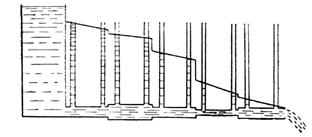 |
АвтоАвтоматизацияАрхитектураАстрономияАудитБиологияБухгалтерияВоенное делоГенетикаГеографияГеологияГосударствоДомДругоеЖурналистика и СМИИзобретательствоИностранные языкиИнформатикаИскусствоИсторияКомпьютерыКулинарияКультураЛексикологияЛитератураЛогикаМаркетингМатематикаМашиностроениеМедицинаМенеджментМеталлы и СваркаМеханикаМузыкаНаселениеОбразованиеОхрана безопасности жизниОхрана ТрудаПедагогикаПолитикаПравоПриборостроениеПрограммированиеПроизводствоПромышленностьПсихологияРадиоРегилияСвязьСоциологияСпортСтандартизацияСтроительствоТехнологииТорговляТуризмФизикаФизиологияФилософияФинансыХимияХозяйствоЦеннообразованиеЧерчениеЭкологияЭконометрикаЭкономикаЭлектроникаЮриспунденкция
Current of a liquid on a pipe of variable section and branched out
 Speeds of current of a real liquid in a horizontal pipe of variable section on various sites of a pipe differ also gradients of pressure accordingly differ.
Speeds of current of a real liquid in a horizontal pipe of variable section on various sites of a pipe differ also gradients of pressure accordingly differ.
For liquids, with small viscosity, current can differ at low speeds and average levels of pressure differ too (rule Bernoulli). Besides in places of change of section of a pipe the turbulences causing significant losses are formed. Therefore usually static pressure along all pipes of variable section falls and more abruptly on sites of smaller section. The gradient of pressure depends on the general section of the branched out part in the branched out pipe. Under the formula of Newton force FB of internal friction is proportional to a gradient of speed in a direction of radius of a pipe. The gradient of speed, as shown in figure, has the greatest size near the wall of pipe and the least in its central part. Hence, force of internal friction and losses of energy of a liquid in layers, there are near the wall of pipe, considerably above, than in central. Therefore, if to compare the general losses of energy on internal friction in a continuous pipe and in branched out (at identical general section) it will appear, that in the latter case when the general surface is more than layers, there are near the wall of pipe, these losses considerably above.
 It follows as well from formula Gagen-Puazal, according to which hydraulic resistance in inverse proportion to the fourth degree of radius of a pipe. By simple transformations of this formula it is possible to show, that for the branched out pipe consisting from п pipers, resistance to current of a liquid at identical general section and other equal conditions will be in п times more in comparison with not branched out pipe. Accordingly in п time increases also a gradient of pressure.
It follows as well from formula Gagen-Puazal, according to which hydraulic resistance in inverse proportion to the fourth degree of radius of a pipe. By simple transformations of this formula it is possible to show, that for the branched out pipe consisting from п pipers, resistance to current of a liquid at identical general section and other equal conditions will be in п times more in comparison with not branched out pipe. Accordingly in п time increases also a gradient of pressure.
Поиск по сайту: